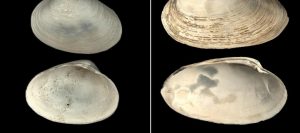
Clams, mussels, scallops and oysters sound like delicious items on a restaurant menu. But bivalves such as these are much more than that: They function as a delicate record of changing environments and climate.
They live for a long time in one place, all the while accumulating information about their environment in their shells.
Precise timing of a climate gas release
17,707 to 16,680 years ago, around the end of the last Ice Age, clams were alive and kicking on the seabed of the Arctic Ocean above 79° North. That is a pretty accurate time frame that proves persistent methane release from the Arctic Ocean floor for approximately a thousand years.
CAGE scientists discovered the colonies while X-raying two sediment cores from the ocean floor offshore Svalbard, collected at 1200-meter water depth. The discovery was published in Geochemistry, Geophysics and Geosystems.
“We have not discovered these chemosynthetic-based communities in any of the other cores found this far North, and as far as I know they have never been observed in the high Arctic at all.” says principal author, professor William Ambrose, visiting scholar at CAGE.
Don´t need sunlight to thrive
The clams did not exist in a food chain based on photosynthesis. The sunlight does not penetrate this deep into the ocean. Instead, they derived a large portion of their sustenance from a community of bacteria that convert carbon in the ocean into sugars and other byproducts with the help of methane seeping from the ocean floor.
“Our calculations show that 43 percent of their nutrition came from methane. The rest comes from different sources, among others photosynthetic material falling through the water. But at this depth that is not a lot. The methane is key to this species living there.” says Ambrose
Hot and cold release
Methane seeps out from the ocean floor in two environments: hydrothermal vents, huge plumes of hot smoke that appear close to areas of volcanic activity; or from less dramatic cold seeps that are more elusive. Both environments, however, are characterized as deep-sea biological oases that support an abundance of chemosynthetic-based communities.
“Bivalves of this species on the modern seabed as well as in the sediment are a good indicator of methane release.” says Ambrose
Clams act as natural observatories
The release measured in this study was recorded in Vestnesa Ridge. This is an area known as a gas hydrate province with at least a million years of methane release. Gas hydrates are a solid, ice-like form of methane stored under the ocean floor. They release methane gas when they melt.
Several spots in Vestnesa are very active today, even releasing huge columns of gas up to 800 meters tall. Others are inactive. How the release gets activated has been established previously by CAGE research. But the duration of the release event is not easily understood.
“Bivalves act like natural observatories. These clams have average life span up to 30 years. Some species can even be hundreds of years old.”
Think of the clamshells as vinyl records, recording methane release through decades in the groves of their shells, without missing a beat. A shell bed of 30 cm, such as one found in the sediment core from Vestnesa Ridge, represents a formidable record collection, which can be played back by measuring isotopes and elements in the shells
“By dating when the clams lived, and the isotopic values in their shells, we were able to calculate that methane had to persistently leak out of its natural reservoir at this particular site for a thousand years for this clam collection to form.”
Takes advantage of CAGE expertise
The precise, and robust dating of such an event in our planet’s distant history is not a straightforward process, and does not depend on clams alone. A lot of elements must be in place to achieve this degree of precision: microfossils must be dated, carbonate crusts also, and tectonic movements must be understood.
“This study really takes advantage of the close proximity of all the different expertise that is available at CAGE and is a good example of interdisciplinary work. ” concludes Ambrose.
Reference:
William G. Ambrose et al. Bivalve shell horizons in seafloor pockmarks of the last glacial-interglacial transition: a thousand years of methane emissions in the Arctic Ocean, Geochemistry, Geophysics, Geosystems (2015). DOI: 10.1002/2015GC005980
Note: The above post is reprinted from materials provided by Centre forArctic Gas Hydrate, Environment and Climate.










